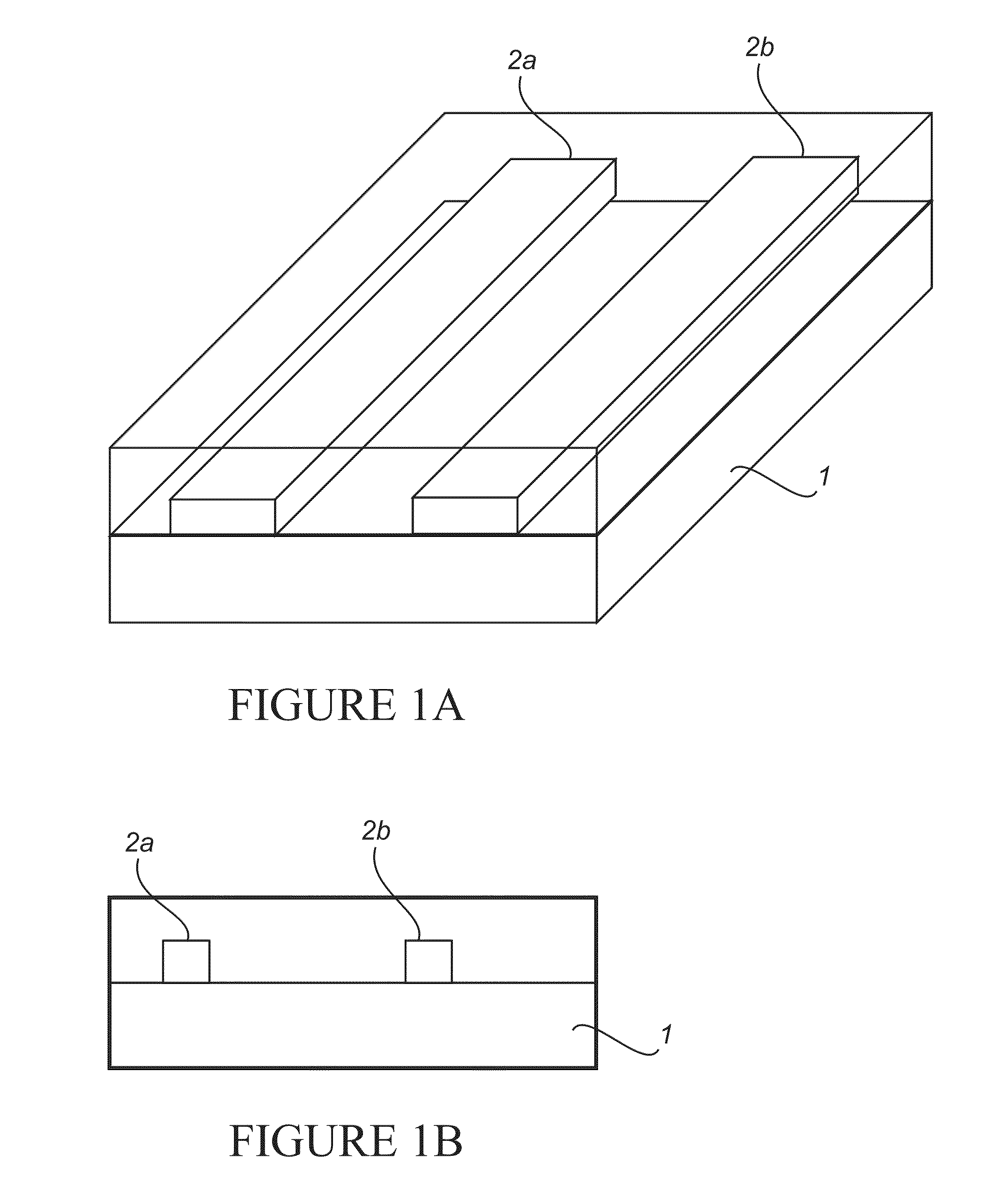Nano-Scale Biosensors
a biosensor and nano-scale technology, applied in diagnostic recording/measuring, laboratory glassware, instruments, etc., can solve the problems of changing the melting temperature, changing the thermodynamic properties, and requiring expensive fluorescent microscopes to visualize data, etc., to achieve low power, easy to use, and easy to recycle
- Summary
- Abstract
- Description
- Claims
- Application Information
AI Technical Summary
Benefits of technology
Problems solved by technology
Method used
Image
Examples
example 1
[0446]A two-step photolithography process was used to achieve the structures on a thermally oxidized silicon wafer. In the first step of photolithography, a 3 μm wide line pattern was defined and e-beam evaporation of 50 Å of titanium (as sticky layer) and 150 Å of gold was done (FIG. 15). Lift-off created the metal lines on the wafer. The second optical lithography was done to pattern probing pads aligned to the metal lines. The probing pads were made of 100 Å titanium and 500 Å gold.
[0447]In this example, a manual focused-ion beam (FIB) milling process was performed on metal lines to make a scratch on the surface of the metal. A 30 KV acceleration voltage was used for the FIB scratching using gallium ions. A number of characterization runs were carried out to ensure that FIB does not remove all of the metal line during scratching.
[0448]The FIB based partial scratching of the metal lines creates controlled nano-gaps for break junction fabrication. This ensures a minimal footprint F...
example 2
[0457]The chips with nanoelectrodes were fabricated in two steps of lithography. On the first layer Ti / Au thickness 50 / 150 Å metal pads 500 nm apart were made using e-beam lithography and lift-off. In the second step, optical lithography was done to fabricate probing pads to contact the nanoelectrodes. Bare silicon chips were used to test the attachment and detection schemes prior to using nanoelectrode chips.
[0458]The chips were cleaned in oxygen plasma at 200 W in Ar+O2 and Piranha solution, followed by surface attachment of probe DNA in a nitrogen glovebox with controlled ambience and temperature, as described in S. M. Iqbal, D. Akin, and R. Bashir, Nat. Nanotechnol., 2, 243-8 (2007), incorporated herein by reference. The surface-attached probe molecules were heat cycled in TrisEDTA (TE) buffer three times to ensure all molecules formed hairpin loop structures. The gold nanoparticle reporter conjugates were prepared using thiol-gold chemistry, as described in J. J. Storhoff, R. E...
example 3
Materials
[0485]Chemicals used in this example were purchased from Sigma-Aldrich (St. Louis, Mo.), except that the 3-amino modified DNA strands were purchased from Alpha DNA (Montreal, Quebec). The DNA binding domain from the Bombyx mori retrotransposon protein R2Bm was made in accordance with S. M. Christensen, A. Bibilio, and T. H. Eickbush, Nucl. Acids Res. 33:6461-6468 (2005). The zinc finger and myb motif of the R2Bm protein binds to a specific double stranded DNA sequence (5′-CTTAAGGTAGCAAATGCCTCGTC-3′; SEQ ID NO:4) with the gene coding for the large ribosomal subunit.
Method
[0486]Fabrication of the CMOS Chip: Chips were fabricated in two steps of lithography. On the first layers Ti / Au (thickness 50 Å / 150 Å) metal pads 500 nm apart were made using e-beam lithography. Metal lift-off resulted in well-defined structures. In the second step, optical lithography was used to fabricate probing pads to contact the thin film electrodes.
[0487]Surface modification and attachment of double-...
PUM
| Property | Measurement | Unit |
|---|---|---|
| width | aaaaa | aaaaa |
| size | aaaaa | aaaaa |
| size | aaaaa | aaaaa |
Abstract
Description
Claims
Application Information
 Login to View More
Login to View More - R&D
- Intellectual Property
- Life Sciences
- Materials
- Tech Scout
- Unparalleled Data Quality
- Higher Quality Content
- 60% Fewer Hallucinations
Browse by: Latest US Patents, China's latest patents, Technical Efficacy Thesaurus, Application Domain, Technology Topic, Popular Technical Reports.
© 2025 PatSnap. All rights reserved.Legal|Privacy policy|Modern Slavery Act Transparency Statement|Sitemap|About US| Contact US: help@patsnap.com



